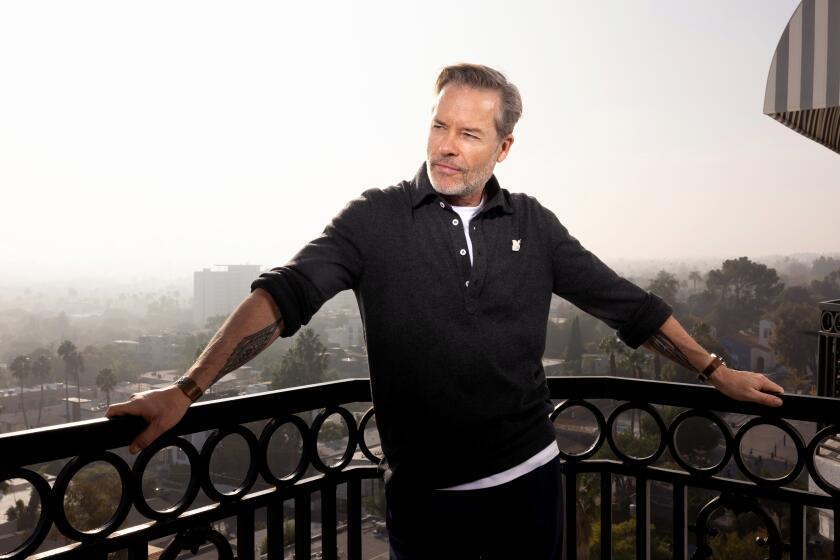MOVIE REVIEW : MESMERIZING STROKES IN ‘SWIMMING TO CAMBODIA’
- Share via
In the audacious and vastly entertaining “Swimming to Cambodia” (Beverly Center Cineplex), actor and monologuist Spalding Gray tries for the almost-impossible: variety and fascination in a one-man show of the most sedentary kind. Richard Pryor at least prowls the stage in his concerts, orchestrating his characters with his entire body. Gray sits at a desk, a movie screen behind him, a faintly manic glint in his eye and talks. And it is hilarious, horrifying, mesmerizing; an evening that is over only too soon.
“Swimming to Cambodia” is a tour through Gray’s magpie mind as he ruminates about the considerable sex, politics, behind-the-scenes movie gossip and manic camaraderie that attended the making of “The Killing Fields” in Thailand in 1984, a film in which Gray had a small role. The movie has grown out of Gray’s long performance piece, which he staged across the country, but for the film he’s cut it almost in half.
As Gray tells it, “The Killing Fields’ ” director, Roland Joffe, a man “with the body of Zorro, the soul of Jesus and the eyes of Rasputin,” asked him what he knew about the tangled political background of Cambodia. Gray said cautiously, “I’m not very political--I’ve never even voted.”
“Perfect,” was Joffe’s reply. “We’re looking for someone to play the American ambassador’s aide.”
And so, Gray’s brush with movie making began.
Director Jonathan Demme choreographs the filming of Gray’s performance so that it seems to fly by, using three cameras, wizardly editing, and mysterious musical effects by Laurie Anderson. Sometimes we rush forward, toward Gray’s steel-gray handsome head as though we were about to co-inhabit his brain. At other times the lights fade down mysteriously, making us strain forward in the gloom to make contact with our guide.
Demme seems to possess that sort of imagination that solves fiendish match-stick puzzles, where to win you must step beyond the given framework. The restrictions of the performance piece--a man, a desk, a child’s notebook, a pull-down map, a pointer, a movie screen are, indeed, its sole elements--only seem to energize him and make his imagination cook. While Gray’s circular storytelling patterns remain completely lucid, “Swimming to Cambodia” is deft and elegant, an even more magical work than Demme’s earlier concert film, “Stop Making Sense.”
Spalding Gray is as compelling a storyteller as Garrison Keillor, but they are as far apart in tone as Lake Wobegon from Cambodia. The sophisticated Gray, with a trace of Boston in his voice and the smallest speech impediment, a Bogart-like “s” sound, deals in ironic soul-baring. When he describes his artist’s search for “the perfect moment,” which he roots about for in the sex clubs and the turquoise waters around Bangkok, he risks our smug smiles--and turns them back on himself. His stance as a political naif allows him to lead us through the political-historical background of Cambodia, Thailand and, not incidentally, our own country in the mid-1970s, a disarming ploy.
And so we are drawn into the horrors of Cambodia under Pol Pot, into movie making with its indecent perks under a messianic director (and a cast that included writer-director Athol Fugard, no mean hand at irony himself), into Gray’s encounters with his lady-love, Renee, who is determined “to give her man space” but not too much rope. And finally, into some pretty exotic R & R, indulged in by virtually the entire company, because it was Southeast Asia, after all, and who knew when anyone would be there to sample its epic hedonism again.
“Swimming to Cambodia” is soaring, unsparing and brilliantly observed. It is also a comment on the power of storytelling. In Gray’s dry, seemingly dispassionate way, as he reads the gallant letter from Prince Sirik Matak, the Cambodian leader who refused to leave his country and “whose liver would be carried through the streets on a stick five days later” by the Khmer Rouge, he places the events in Cambodia inside our heads as vividly as “The Killing Fields.” With one-hundredth of the cast.
More to Read
Only good movies
Get the Indie Focus newsletter, Mark Olsen's weekly guide to the world of cinema.
You may occasionally receive promotional content from the Los Angeles Times.










